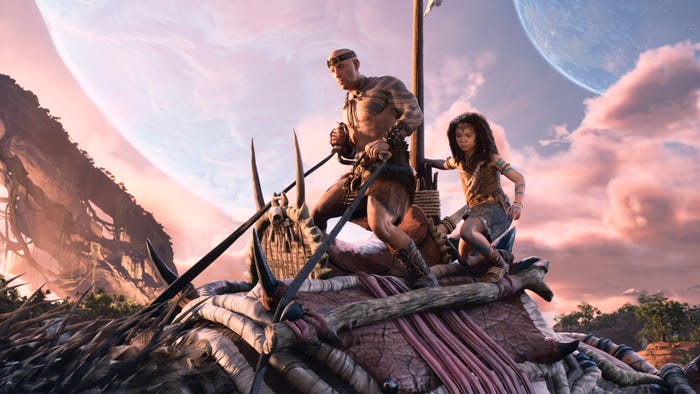Q&A: Implementing and balancing traversal mechanics in Grow Up
"We had a vision of an unbounded planet very early on, a place where BUD could explore a world from any angle in any way without linearity."

We recently got in touch with the Ubisoft Reflections team to chat about Grow Up, the sequel to last year's procedurally animated action platformer Grow Home. The game is built around a Botanical Utility Droid (BUD) who must save his planet by cultivating the seeds of enormous alien plants. Players spend much of the game time leaping, clambering, and gliding around the mountainous flora you have grown.
Looking at the sequel, we wanted to learn how a small team managed to implement meaningful changes in a relatively short space of time. Many folks at Ubisoft Reflections took the time to answer of our questions.
Looking back at what you feel Grow Home got right and wrong, what did hope to achieve with the sequel?
Jack Couvela, art director: When planning a second outing, we built on all the features that players loved about the first game while making sure we were bringing something very new. We really wanted to expand BUD’s world horizontally to give him more than one climb.
This meant we could unlock the rocket pack and glider much earlier, as there was a lot more traveling to do, as well as developing other ways to throw BUD across the map, such as with his new ball boost ability.
The handful of interactive plants in Grow Home developed into a whole Floradex packed with 24 brand new plants that help you explore by growing them wherever you want.

By using procedural geometry generation tools, we were able to build an entire planet -- while keeping the loving craftsmanship that went into the creation of the world, courtesy of our level designer Liam -- with almost the same tiny team size as before.
All of this turned Grow Up into a much faster and more acrobatic adventure than the first game, moving the core focus away from climbing and into the air.
Doubling down on two of Grow Up's new features -- the Power Glider and Ball Mode -- how did you hope they'd impact gameplay?
Dale Scullion, game designer: To achieve the vision of the new planetary playground, we were dealing with a much bigger play space; therefore, BUD needed some new tools to get around.
The ability to combine moves like the ball and power glider allows for a greater sense of mastery over the clumsy little robot. We also felt this would be a natural progression in giving Grow Home players a new experience.
The charge of the ball allows BUD to gain momentum, instantly turning big open spaces into glorious passageways, while it also shows off the physicality that is at the heart of Grow Up.
Combining this charge with the power glider makes island-hopping a breeze. All of these abilities are punctuated with BUD's core climbing mechanic, making for a very unique gameplay experience.
How did you implement both of those systems without tipping the balance?
Andy Buck, senior programmer: For the glider, we knew we already had a fun toy in the leaf from Grow Home so it's only a very slightly modified version of that. We adjusted its fall rate so you could glide horizontally for longer distances to support the more horizontal gameplay and exploration of Grow Up.
We also added some engines (driving forces) for the more upgraded versions of the glider. We took lots of care to tune those values so they were just right, but there were very few technical difficulties in its implementation.

The ball-mode is a little different; it’s a new feature invented just for Grow Up. Like many of our gameplay ideas, it started as a simple physical toy created by a member of our team.
During its development, it gained and lost all sorts abilities and constraints, from climbing up walls to floating in water. In the end, we settled on something pure that was easy to understand and simple to use alongside the other abilities.
Did the new features change your approach to world design in a big way?
Liam Charlton, level designer: Yeah, BUD/s new abilities were a huge consideration in the design of the world. Where Grow Home focused on vertical movement, Grow Up's natural progression is equally about horizontal traversal.
We had a vision of an unbounded planet very early on, a place where BUD could explore a world from any angle in any way without linearity. This meant the world design had to provide space for that kind of exploration – in all directions – while still holding the player’s hand long enough to for them to learn the skills that make the experience fun.
Most notably, the new abilities inspired the vantage points and glide spaces where the breathtaking beauty of the planet is always on display, offering a unique way to explore the world from a completely new perspective.
About the Author(s)
You May Also Like













